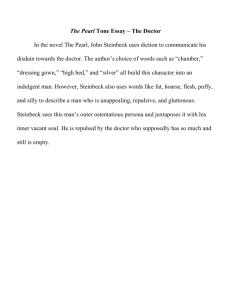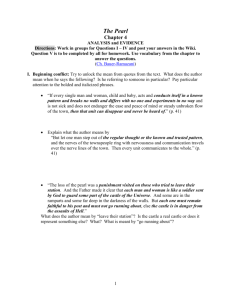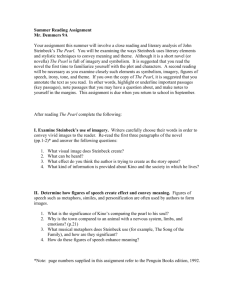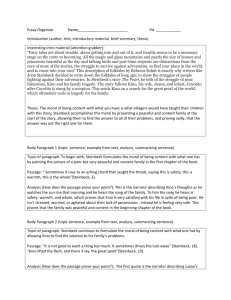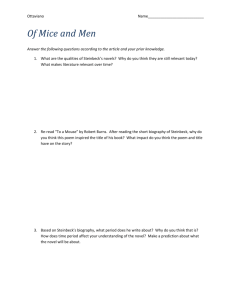Cristi Martino - Marlboro Central School District
advertisement
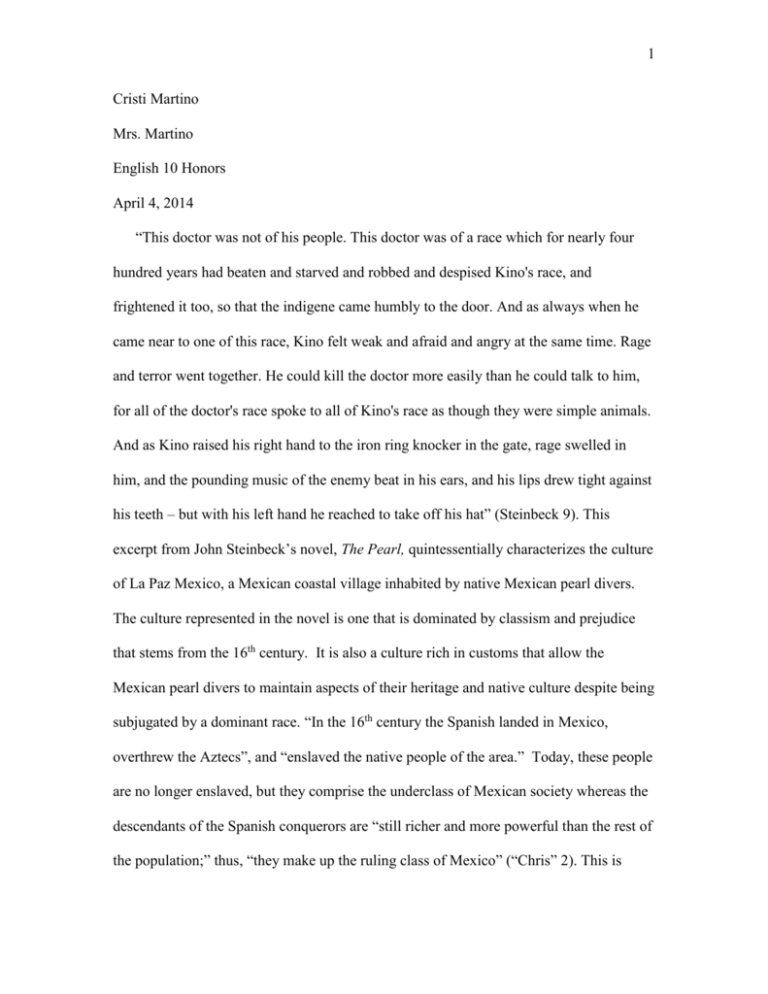
1 Cristi Martino Mrs. Martino English 10 Honors April 4, 2014 “This doctor was not of his people. This doctor was of a race which for nearly four hundred years had beaten and starved and robbed and despised Kino's race, and frightened it too, so that the indigene came humbly to the door. And as always when he came near to one of this race, Kino felt weak and afraid and angry at the same time. Rage and terror went together. He could kill the doctor more easily than he could talk to him, for all of the doctor's race spoke to all of Kino's race as though they were simple animals. And as Kino raised his right hand to the iron ring knocker in the gate, rage swelled in him, and the pounding music of the enemy beat in his ears, and his lips drew tight against his teeth – but with his left hand he reached to take off his hat” (Steinbeck 9). This excerpt from John Steinbeck’s novel, The Pearl, quintessentially characterizes the culture of La Paz Mexico, a Mexican coastal village inhabited by native Mexican pearl divers. The culture represented in the novel is one that is dominated by classism and prejudice that stems from the 16th century. It is also a culture rich in customs that allow the Mexican pearl divers to maintain aspects of their heritage and native culture despite being subjugated by a dominant race. “In the 16th century the Spanish landed in Mexico, overthrew the Aztecs”, and “enslaved the native people of the area.” Today, these people are no longer enslaved, but they comprise the underclass of Mexican society whereas the descendants of the Spanish conquerors are “still richer and more powerful than the rest of the population;” thus, “they make up the ruling class of Mexico” (“Chris” 2). This is 2 similar to American culture in that our Nation has a history rich in slavery and subjugation; however, our society has evolved to the point where slavery was officially abolished and all American Citizens are protected and guaranteed equal rights under the Civil Rights Act of 1964. This Act “prohibits discrimination on the basis of race, color, religion, sex or national origin” (“The” 1). Reading and learning about the MexicanIndian culture has lead to a more insightful understanding of and greater appreciation for certain aspects of American culture, namely the belief in equality and fairness that is ingrained in many aspects of the American way of life. The novel, The Pearl by John Steinbeck depicts a culture that is dominated by classism and gender inequality. To begin, an unjust social hierarchy is at the epicenter of the culture of LaPaz, Mexico. For instance, at the beginning of the story, the main character’s infant son is stung by a scorpion, and they are afraid that the sting will be fatal. Since the main characters are members of the lower class of native pearl divers, they rarely travel to the town or interact with members of the upper social class. Considering the gravity of their son’s situation, they consult a doctor, who is a representative of the richer, more powerful social class. The doctor curtly responds: “Have I nothing better to do than cure insect bites for ‘little Indians’? I am a doctor, not a veterinary” (Steinbeck 11). This shows how the culture in LaPaz is one that is dominated by classism because the doctor clearly considers himself to be superior to the main characters due to his class and race. His refusal to treat a critically ill baby because he is a “little Indian” shows how little regard this upper class has for the natives; he feels as though this “little Indian’s” life is not worth saving. Moreover, he compares this Indian baby to an animal by saying, “I am … not a veterinary” (Steinbeck 11). This is further 3 evidence that the culture is dominated by a class system that breads unfairness. In addition, gender inequality is another distinctive feature of the culture represented in the novel. This inequality is represented through Juana, the main character’s wife. After the doctor refuses to treat their infirmed son, Kino and Juana set out to find a pearl so they can have money to pay the doctor. In a stroke of good fortune, Kino finds “The Pearl of the World” which he believes will solve all of their problems, including their son’s ailment as well as the inferiority they’ve suffered throughout their lives. Unfortunately, the pearl only brings misery, violence and corruption, and at one point, Juana tries to throw the pearl back into the sea. As a result, Kino feels betrayed by his wife and beats her. It is at this point where the gender inequality becomes apparent through Juana’s response: “He had said, ‘I am a man,’ and that meant certain things to Juana. It meant that he was half insane and half god. … And yet it was this thing that made him a man, half insane and half god, and Juana had need of a man; she could not live without a man” (Steinbeck 59). This reveals how gender inequality is another aspect of this culture because Juana has learned that she must accept certain aspects of her life simply due to the fact that she is a woman. Even though Kino is changing and has even beaten her at this point, she must stay with him because “she had need of a man.” This implies that she could not survive in this society without a man; without a man, she could not provide even the basic necessities of life – food, clothing, and shelter. Clearly, based on the characters and events portrayed in the novel, class and gender inequality are inherent parts of the culture in LaPaz, Mexico. Reading about this culture in the novel raised many questions, and through researching the culture, it became clear that it is a culture rich in religion and indications 4 of social classes. Primarily, family and faith are at the heart of life in Mexico; therefore, a town square with a church is at the center of the majority of towns and cities (Weibel 1). This aspect of Mexican culture is present even in LaPaz. After the Spanish Conquest of LaPaz, “Catholic friars spread through the land establishing missions” (“Mexico” Lands 353). Now, approximately 77% of Mexicans are Roman Catholic, and “the Catholic Church has greatly influenced the culture, attitudes, and history of all Mexicans, and Catholic holidays are celebrated widely” (“Mexico” Culture 1). In LaPaz, “Our Lady of La Paz Cathedral, located on one end of Velasco Gardens in the central square, is the most important religious center in the city of La Paz” (Weibel 1). This clearly shows how religion became and is a part of the culture of LaPaz. It is clear that the Spanish conquest during the 16th century not only affected the class system in LaPaz, but it also influenced the dominant religious beliefs of the region. Native beliefs have been surpassed by an adherence to Catholicism, and the beliefs of this religion orchestrate holidays and public celebrations. This would explain why Juana’s religious beliefs seem mixed in the novel; she seems to have both native and Catholic beliefs: “Under her breath Juana repeated an ancient magic guard against such evil, and on top of that she muttered a Hail Mary between clenched teeth” (Steinbeck 5). In addition, Mexican culture is one in which the “clothing makes the man,” so to speak. In other words, social class is sometimes indicated by articles of clothing, such as hats. Specifically, in the native culture, “Ancient Aztec clothing, that is, the clothing worn by the tribes that made up the Aztec empire (such as the Mexican people), was rich in variety … [and] it varied according to the social class that people belonged to” (“Ancient” 1). In current Mexican culture, clothing and hats are still an indication of an individual’s social class. According 5 to the CultureGrams database, many indigenous, or native, groups still wear traditional clothing to indicate their devotion to the native culture. Men from rural areas “may wear a wide-brimmed straw hat” whereas “professional men in the north may wear cowboy hats, boots, and jeans” (“Mexico” Culture 1). This provides evidence to explain questions that arose regarding hats while reading The Pearl. In the novel, Kino places importance on how he wears his hat when he goes into town to sell the pearl: “Kino put on his large straw hat and felt it with his hand to see that it was properly placed, not on the back or side of his head, like a rash, unmarried, irresponsible man, and not flat as an elder would wear it, but tilted a little forward to show aggressiveness and seriousness and vigor. There is a great deal to be seen in the tilt of a hat on a man” (Steinbeck 44). Evidently, Kino’s hat and the particular way he wears his hat marks not only his social class but also the way he wants others to view him. Furthermore, when Kino finds the pearl, he states, “We will have clothes,” and he envisions his son wearing “a blue sailor suit from the United States and a little yachting cap” (Steinbeck 24). Based on the information discovered through research, the clothing is a clear indication of a rise in social class. Therefore, two additional aspects of Mexican culture – past and present – are religion and social class. Reading and learning about the Mexican-Indian culture has lead to a more insightful understanding of and greater appreciation for certain aspects of American culture, namely the belief in equality and fairness that is ingrained in many aspects of the American way of life. Primarily, I learned that the culture presented in the novel is one that has a social hierarchy based on class and gender. Although this structure has changed since the time represented in the novel, there still seem to be remnants of the past in the society. 6 Specifically, although the natives like Kino in the novel are no longer slaves, the more prosperous and powerful members of society still seemed to be descendents of the Spanish conquerors (“Mexico” Culture 1). This has created a culture in which the upper class looks down on the poor native people because of their beliefs, their race, and their poverty (“Chris”). This is evidenced in the text through the doctor’s treatment of Kino; in fact, even the doctor’s servant, who is also of native descent, shows superiority towards Kino simply because he works for the upper class: “The gate closed a little, and the servant refused to speak the old language” (Steinbeck 10). I also learned about how clothing, even something as simple as a hat and the way that it is worn, can be an indication of a person’s social class or status. Moreover, I gleaned insight as to the role of women in this particular society through the character of Juana. Although she loves and respects her husband, she also needs her husband. In this particular culture, there is no way for a woman to provide for her family without a man, for the men provided the only source of income through pearl diving. These were important insights for me. I have visited various parts of Mexico, and I have always admired aspects of the Mexican culture such as the devout religious beliefs, the appreciation for traditional music, and to the focus on enjoying life. My understanding of the Mexican culture has definitely been broadened. Moreover, this has lead to a new-found appreciation for certain aspects of American culture. I am ever-more appreciative of the American values of freedom and equality. The Civil Rights Act of 1964 is proof that ours is a culture vested in ensuring equality for all regardless of class, race, religion, or gender. Through reading and learning about the struggles inherent in other cultures, I have definitely gleaned an appreciation for the freedoms I have as an American. As I read about how the doctor 7 refused to treat a dying baby in the novel, I became thankful that American doctors cannot discriminate or refuse to treat patients in need of care. As I read about how Juana had to accept certain things, such as being beaten, simply because she was a powerless in her society, I became thankful for the opportunities that I have had to study and to become financially independent. Hence, reading about and researching a culture outside of the United States, has reaffirmed my beliefs about American culture. Learning about other cultures, even through reading fictional novels, can lead to a new perspective regarding and a greater appreciation for aspects of our own cultures. First, reading The Pearl provided information about the class and gender inequality that is part of the culture in LaPaz, Mexico. Secondly, reading factual information about the Mexican culture added further insight as to the development of religious beliefs and covert dress codes in the society. Lastly, in light of this new knowledge, I gleaned a profound appreciation for many freedoms and opportunities that all American are guaranteed. To conclude, John Steinbeck once said, “Many a trip continues long after movement in time and space have ceased” (“John”). This figurative “trip” that I have taken through reading and research certainly will not “cease” any time soon, for the insights I’ve gained are powerful and meaningful. 8 Works Cited "Ancient Aztec Clothing." Ancient Aztec Clothing. N.p., 2013. Web. 27 Feb. 2014. <http://www.aztec-history.com/ancient-aztec-clothing.html>. "Chris Logsdon." : Home. N.p., n.d. Web. 28 Feb. 2014. <http://www.rcstn.net/chris.logsdon/home>. "The Civil Rights Act of 1964." The Civil Rights Act of 1964. The U.S. Senate Committee on the Judiciary, n.d. Web. 26 Feb. 2014. <http://www.judiciary.senate.gov/about/history/CivilRightsAct.cfm>. "John Steinbeck Quotes." BrainyQuote. Xplore, 2014. Web. 28 Feb. 2014. <http://www.brainyquote.com/quotes/authors/j/john_steinbeck.html>. "Mexico." CultureGrams Online Edition. ProQuest, 2014. Web. 27 Feb 2014. "Mexico." Lands and Peoples. Vol. 5. Danbury: Grolier, Incorporated, 1995. 348-59. Print. "Mexican Culture, History and Art." La Paz. Cotton and Company, 2009. Web. 27 Feb. 2014. <http://www.azuldecortez.com/real_mexico.asp>. Steinbeck, John. The Pearl. New York: Penguin, 1973. Print. Weibel, Barbara. "Historic Cathedral, La Paz, Mexico." Attractions RSS. TripAdvisor LLC., 27 Mar. 2010. Web. 27 Feb. 2014. <http://attractions.uptake.com/blog/lapaz-mexico-catehdral-10179.html>.
